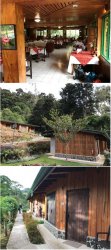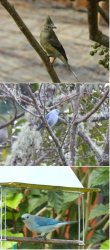You are using an out of date browser. It may not display this or other websites correctly.
You should upgrade or use an alternative browser.
You should upgrade or use an alternative browser.
A high and dry, wild and wet, majestic history medley – RTW 2018
- Thread starter JohnM
- Start date
-
- Tags
- round the world
- Status
- Not open for further replies.
- Joined
- Jun 7, 2006
- Posts
- 11,799
- Qantas
- LT Gold
How big is the memory card, brand, speed and how many pics and space did you use on HDD for pics?
OMG, I just use a Sony HX90V pocket camera - just a toy! It works in the dry but consistently fails totally in humid conditions - seemingly a general Sony issue grumbled about upthread. Just as well I carried a backup pocket Lumix for when I got into Costa Rica (to come).
Snail-pace speed is basically hopeless for wildlife photography in any pocket camera. I'm no photographer. For me, it's just point in the general direction and shoot - but I do use burst mode and hope that something works out. I don't want to be lugging around an SLR. So luck plays a very large part in the outcome for me
Just a repeat of my inferior and inadequate status following along behind on this (and most) trips

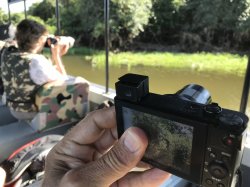
- Joined
- Jun 7, 2006
- Posts
- 11,799
- Qantas
- LT Gold
My little Sony HX90V handles the humidity all right. but I also carry a little waterproof Lumix just in case.
You're lucky. Without exception, mine fails every time I go into very high humidity conditions (not getting it wet - just ultra-high humidity). And it's not the only this model Sony that I've heard about that has problems with high humidity. Within a day or so of returning to dry conditions it resumes functioning as though nothing had happened.
My Lumix is not a waterproof model; it's really just the equivalent model slightly earlier to the Sony and just not quite as compact and doesn't have as good a viewfinder which I use all the time to avoid having to don my glasses and trying to see images clearly on the screen in bright light.
- Joined
- Jun 7, 2006
- Posts
- 11,799
- Qantas
- LT Gold
Moving on to the Pantanal proper.
Some general shots to illustrate the landscape and habitats. Typical tropical savannah vegetation (trees not forming a closed canopy). It was mid-July, so well into the dry season and the smaller pools were almost dry with highly water-dependent wildlife becoming concentrated.


Crabs are abundant. As are giant snails.

And did I say that it is flat?

A swampier area with boardwalk near the lodge.


Plumbeous Ibis. Wattled Jacana. Rhea.

I did show this macaw earlier. It’s semi-tame, having been released near the lodge some years ago and it periodically visits. I can’t recall the species but it is not endemic to this specific area. A couple of other regulars in the garden around the lodge. I don’t know what the yellow one is but the red one is a Yellow-billed cardinal.

Unknown. Rufescent Tiger-heron; unknown friend in the background. I think a Rufous-tailed Jacamer (the problem with taking pics of birds in trees – the backlight destroys detail and colour). Anyway, nice beak…

These Acuri palm nuts are favoured macaw food.

Some general shots to illustrate the landscape and habitats. Typical tropical savannah vegetation (trees not forming a closed canopy). It was mid-July, so well into the dry season and the smaller pools were almost dry with highly water-dependent wildlife becoming concentrated.


Crabs are abundant. As are giant snails.

And did I say that it is flat?

A swampier area with boardwalk near the lodge.


Plumbeous Ibis. Wattled Jacana. Rhea.

I did show this macaw earlier. It’s semi-tame, having been released near the lodge some years ago and it periodically visits. I can’t recall the species but it is not endemic to this specific area. A couple of other regulars in the garden around the lodge. I don’t know what the yellow one is but the red one is a Yellow-billed cardinal.

Unknown. Rufescent Tiger-heron; unknown friend in the background. I think a Rufous-tailed Jacamer (the problem with taking pics of birds in trees – the backlight destroys detail and colour). Anyway, nice beak…

These Acuri palm nuts are favoured macaw food.

- Joined
- Jun 7, 2006
- Posts
- 11,799
- Qantas
- LT Gold
Whistling Heron. Blue-crowned Tragon. Black-collared Hawk.
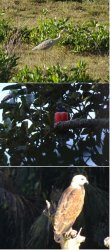
Snail Kite. Blue-fronted Parrot. Monk Parakeets.

Hmmm, what do we have here? Hi tourists! Giant Armadillo.

Awww, sooo cute!

Red-legged Seriema. Several species of deer occur in the Pantanal.
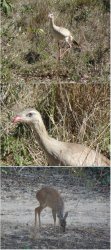
Savanna Hawk. Just lookin’.

Monk parakeets are gregarious nesters.

Hyacinth Macaws.

And a fascinating creature – Giant Anteater. And the nocturnal Pygmy Anteater while spotlighting.

Tapir. Crab-eating Racoon. Fox. We also caught a glimpse of a puma with the light but no chance to take a pic with the dinky camera.

And that wraps up the Pantanal. Next stop Iguassu Falls. I reported on that live with pics from my phone. There may be some pics on my camera for show and tell.

Snail Kite. Blue-fronted Parrot. Monk Parakeets.

Hmmm, what do we have here? Hi tourists! Giant Armadillo.

Awww, sooo cute!

Red-legged Seriema. Several species of deer occur in the Pantanal.

Savanna Hawk. Just lookin’.

Monk parakeets are gregarious nesters.

Hyacinth Macaws.

And a fascinating creature – Giant Anteater. And the nocturnal Pygmy Anteater while spotlighting.

Tapir. Crab-eating Racoon. Fox. We also caught a glimpse of a puma with the light but no chance to take a pic with the dinky camera.

And that wraps up the Pantanal. Next stop Iguassu Falls. I reported on that live with pics from my phone. There may be some pics on my camera for show and tell.
Last edited:
juddles
Suspended
- Joined
- Aug 2, 2011
- Posts
- 5,283
- Qantas
- Platinum 1
Forgive my ignorance, but hasn't anyone ever suggested to them to paint it black?
- Joined
- Jun 7, 2006
- Posts
- 11,799
- Qantas
- LT Gold
Forgive my ignorance, but hasn't anyone ever suggested to them to paint it black?
Now that is a question I didn't think to ask anyone as I wandered about while they were loading the 'Cruisers!
- Joined
- Jun 7, 2006
- Posts
- 11,799
- Qantas
- LT Gold
- Joined
- Jun 7, 2006
- Posts
- 11,799
- Qantas
- LT Gold
A selection of pics from the Parque des Aves on the Brazilian side at Iguassu Falls. Very well done and well worth a visit IMO. There are several very large walk-in aviaries. It’s just opposite the main entry to Falls park and the sightseeing helo landing area, so very conveniently located.






I’ve already covered Iguassu Falls. After flying back to GRU and picking up my DONE5 again for a fairly dreadful AA flight to DFW, it was on to SJO and a two-week circuit of Costa Rica, coming up.






I’ve already covered Iguassu Falls. After flying back to GRU and picking up my DONE5 again for a fairly dreadful AA flight to DFW, it was on to SJO and a two-week circuit of Costa Rica, coming up.
- Joined
- Jun 7, 2006
- Posts
- 11,799
- Qantas
- LT Gold
After interruptions last week, I must get this finished before I head to Sudan, and another TR, in November.
The route in Costa Rica over 15 days. A circuit covering both E and W coasts and the central highlands twice - with a focus on national parks and wildlife.

After leaving San Jose early, a stop for breakfast saw the first encounter with a two-toed sloth. This was followed by spotting a three-toed sloth. Unusually, it was walking on the ground in a field as we headed to the berth area for the boats that take visitors into the waterways leading to isolated Tortuguero National Park. Off to a good start!
Tortuguero NP is very popular but the extensive waterways and thick rainforest means that the various lodges are quite well hidden and separated from one another.




Some of the rainforest flora in the grounds of the lodge.



The route in Costa Rica over 15 days. A circuit covering both E and W coasts and the central highlands twice - with a focus on national parks and wildlife.

After leaving San Jose early, a stop for breakfast saw the first encounter with a two-toed sloth. This was followed by spotting a three-toed sloth. Unusually, it was walking on the ground in a field as we headed to the berth area for the boats that take visitors into the waterways leading to isolated Tortuguero National Park. Off to a good start!
Tortuguero NP is very popular but the extensive waterways and thick rainforest means that the various lodges are quite well hidden and separated from one another.




Some of the rainforest flora in the grounds of the lodge.



- Joined
- Jun 7, 2006
- Posts
- 11,799
- Qantas
- LT Gold
An afternoon visit across the main waterway to the village of Tortuguero, the turtle conservancy and the nearby beach where turtles come to nest on the edge of the treeline. I didn’t bother with the night visit to watch egg-laying as I’d seen it before. No photos were allowed. Red-winged Grasshopper – about 6-7 cm long. Sunset as we headed back to the lodge.


Twice/day boat excursions for wildlife-spotting. Photography, especially of animals using a dinky camera, is not easy in rainforest with the low light caused by cloud cover and rain, and obscured views in its dense canopy.


An excellent find! Two-toed sloth hangin’ about. And with a baby – awww, sooo cute!




Twice/day boat excursions for wildlife-spotting. Photography, especially of animals using a dinky camera, is not easy in rainforest with the low light caused by cloud cover and rain, and obscured views in its dense canopy.


An excellent find! Two-toed sloth hangin’ about. And with a baby – awww, sooo cute!


- Joined
- Jun 7, 2006
- Posts
- 11,799
- Qantas
- LT Gold
Night walks were interesting. With flash not permitted, it seemed easier to get better (but not great) photos in the light of a torch with an iPhone than with a camera.
Frogs and a solitary leaf-cutter ant either lost or doing overtime.

Unknown spider and two orb-weavers.

Katydids and crickets.

Cicada, stick insect, mantid.
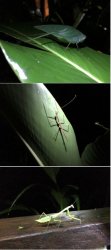
Tent bats partly cut through the veins in these palm leaves to making a shelter. Nice spider. Helmetted lizard.

Iguanas.

Frogs and a solitary leaf-cutter ant either lost or doing overtime.

Unknown spider and two orb-weavers.

Katydids and crickets.

Cicada, stick insect, mantid.

Tent bats partly cut through the veins in these palm leaves to making a shelter. Nice spider. Helmetted lizard.

Iguanas.

- Joined
- Jun 7, 2006
- Posts
- 11,799
- Qantas
- LT Gold
Leaving Tortuguero and having to stop for a banana ‘train’ to cross the road. The rail connecting each side was swung out across the road from one side until the ‘train’ had gone through. The track into the plantation.

Then on to La Fortuna, a pleasant town and entry point for the Mt Arenal national park. Mt Arenal from the town was obscured by cloud most of the time. Trekking in the NP the next day to finish at a view point on the other side of Mt Arenal, which is still mildly active.

Nice wasp. Orb weaver - note the larger female in the middle and the diminutive male top centre. Chunky caterpillar.

Stick insect. Caterpillars.

Small viper. Beetles.

Beautiful coloured and symmetrical mushroom. The fern-like appearance of the leaves on this tree are the result of insect feeding. Damselfly (same Order as dragonflies but distinguished by the wings being folded back in line with the body). They also tend to ‘flutter’ beautifully in flight.

Get the light on the right angel and it becomes evident why it’s called the Golden Orb-weaver.

Beautiful moth and butterfly.

Volcan Arenal. Cloud cleared momentarily. It was very active until quite recently. And a splash of colour in the trees.

La Fortuna waterfall. 65 m drop.


Then on to La Fortuna, a pleasant town and entry point for the Mt Arenal national park. Mt Arenal from the town was obscured by cloud most of the time. Trekking in the NP the next day to finish at a view point on the other side of Mt Arenal, which is still mildly active.

Nice wasp. Orb weaver - note the larger female in the middle and the diminutive male top centre. Chunky caterpillar.

Stick insect. Caterpillars.

Small viper. Beetles.

Beautiful coloured and symmetrical mushroom. The fern-like appearance of the leaves on this tree are the result of insect feeding. Damselfly (same Order as dragonflies but distinguished by the wings being folded back in line with the body). They also tend to ‘flutter’ beautifully in flight.

Get the light on the right angel and it becomes evident why it’s called the Golden Orb-weaver.

Beautiful moth and butterfly.

Volcan Arenal. Cloud cleared momentarily. It was very active until quite recently. And a splash of colour in the trees.

La Fortuna waterfall. 65 m drop.

- Joined
- Jun 7, 2006
- Posts
- 11,799
- Qantas
- LT Gold
The next destination was Monteverde in the cloud forest and walks in two reserves, including an extensive canopy walk with about five suspension bridges on a lengthy circuit. The astounding thing to observe on the above-canopy walkways was the great abundance of flowers and fruits on the upper surface of the trees. This was totally obscured from the ground – and of course readily explained why the birds and monkeys stay so high in the canopy.

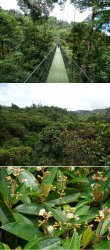

Denizens of the canopy.

And back at the lodge trying to get humming birds to stay still…
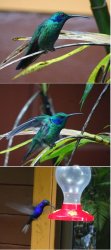
Then moving on and down towards the west coast, leaving the cloud forest behind us before we made a stop at a small nature reserve on the way to Manuel Antonio NP.


The small, often brightly-coloured, frogs of Costa Rica are hard to get a focus on close-up. Damsel flies in copula. They looked brilliant fluttering and twirling in flight in the dappled sunlight, but impossible to photograph like that.

Fungi abound and thrive in the wet conditions. Nice grasshopper.

Manuel Antonio NP and the nearby town is a popular weekend destination at the beach for the locals. It’s pleasant enough but the beach has no surf and is pretty ordinary for an Australian, but the poms in the group enjoyed it. A sloth was spotted. The White-face Capuchin monkeys are cute but highly habituated to humans and can be a nuisance raiding picnic hampers and backpacks.




Denizens of the canopy.

And back at the lodge trying to get humming birds to stay still…

Then moving on and down towards the west coast, leaving the cloud forest behind us before we made a stop at a small nature reserve on the way to Manuel Antonio NP.


The small, often brightly-coloured, frogs of Costa Rica are hard to get a focus on close-up. Damsel flies in copula. They looked brilliant fluttering and twirling in flight in the dappled sunlight, but impossible to photograph like that.

Fungi abound and thrive in the wet conditions. Nice grasshopper.

Manuel Antonio NP and the nearby town is a popular weekend destination at the beach for the locals. It’s pleasant enough but the beach has no surf and is pretty ordinary for an Australian, but the poms in the group enjoyed it. A sloth was spotted. The White-face Capuchin monkeys are cute but highly habituated to humans and can be a nuisance raiding picnic hampers and backpacks.

- Joined
- Jun 7, 2006
- Posts
- 11,799
- Qantas
- LT Gold
Been a bit busy last week; back to it.
Terrible background but a beautiful bird on the wires near the hotel at Manuel Antonio. Endangered Squirrel Monkey.

Moving on to a rainforest nature reserve in the Golfito region in the SW of Costa Rica.
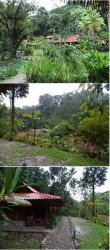
Good find on the first walk – the famed Red-eyed Green Treefrog. And some of the rubbish bird and plant life – including a hummingbird nest with eggs.


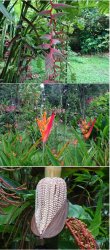
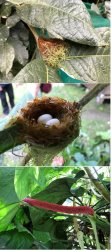
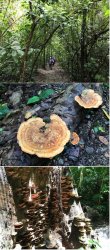
Funnily enough, it often rains in the rainforest.

Terrible background but a beautiful bird on the wires near the hotel at Manuel Antonio. Endangered Squirrel Monkey.

Moving on to a rainforest nature reserve in the Golfito region in the SW of Costa Rica.

Good find on the first walk – the famed Red-eyed Green Treefrog. And some of the rubbish bird and plant life – including a hummingbird nest with eggs.





Funnily enough, it often rains in the rainforest.

- Joined
- Jun 7, 2006
- Posts
- 11,799
- Qantas
- LT Gold
Read our AFF credit card guides and start earning more points now.
AFF Supporters can remove this and all advertisements
- Joined
- Jun 7, 2006
- Posts
- 11,799
- Qantas
- LT Gold
Leaving the rainforest, we began the drive up into the cloud forest of the central mountains.
A morning stop at a café with hummingbird feeders made for an interesting break, albeit frustrating at times trying to photograph the speedy birds with a dinky camera. Burst mode, point, click, see what happens…



A morning stop at a café with hummingbird feeders made for an interesting break, albeit frustrating at times trying to photograph the speedy birds with a dinky camera. Burst mode, point, click, see what happens…



- Joined
- Jun 7, 2006
- Posts
- 11,799
- Qantas
- LT Gold
- Status
- Not open for further replies.
Become an AFF member!
Join Australian Frequent Flyer (AFF) for free and unlock insider tips, exclusive deals, and global meetups with 65,000+ frequent flyers.AFF members can also access our Frequent Flyer Training courses, and upgrade to Fast-track your way to expert traveller status and unlock even more exclusive discounts!

AFF forum abbreviations
Wondering about Y, J or any of the other abbreviations used on our forum?Check out our guide to common AFF acronyms & abbreviations.
Currently Active Users
- Steady
- karmics
- Human
- opusman
- jkbaus
- APACFlyer
- mcbling
- JYK
- Wanderlust_tim
- Forg
- Tlee
- flyingfan
- Austman
- Traveller X
- million_thanas1968
- Hawk529
- JohnM
- brissie
- sudoer
- Rebus
- bullerdude
- am0985
- Leigh744
- Tacan2
- RooFlyer
- Scash
- faulknerhj
- Fatcat_jr
- vbroucek
- AFF_Founder
- lunne
- darv
- wenglock.mok
- Dudditz
- concussed
- rbjhan
- Ikara
- Gonetroppo
- Lockers
- KTA Return
- mccaffd
Total: 1,310 (members: 49, guests: 1,261)

















